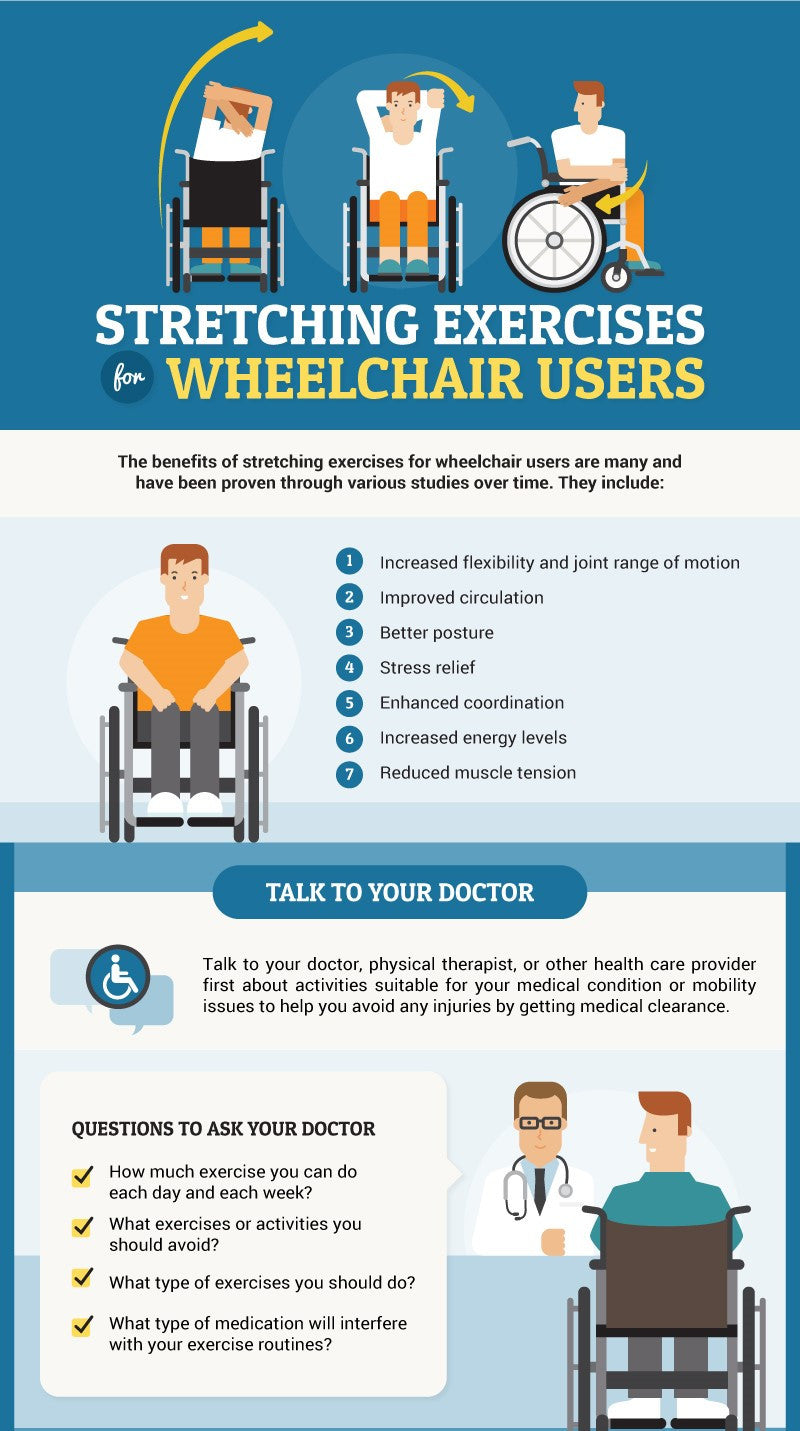
How to exercise in a Wheelchair
Benefits of Stretching Exercises for Wheelchair Users
Studies have been conducted and proven worldwide that stretching exercises provide a variety of benefits to wheelchair users. Benefits include increased flexibility, improved circulation, stress relief, improved posture, enhanced coordination, increased energy levels, reduced muscle tension and joint range of motion.

Stretching Exercises for Wheelchair Users
- For the first exercise you will want to hold your left elbow with your right hand. Gently pull your elbow behind your head until a gentle stretch is felt in your shoulder or back of your upper arm. You will then repeat the same steps for the opposite arm.
- Hold your left elbow with your right hand and gently pull your elbow behind your head until an easy stretch is felt. Then gently lean sideways from your hips to stretch along the side of your upper body. You will repeat the same steps for the opposite arm.
- For this exercise you will raise your arms above your head with your palms facing up. Push your arms slightly back and then upwards. You will feel the stretch in your arms, upper back and shoulders.
- The technique of this exercise should be specifically discussed with your doctor or physical therapist if you have chest, spine or back injuries. For this exercise you will keep your hips straight in the chair, turn your upper body to the right and then to the left. Turn so that you can see over your shoulder. This exercise allows you to stretch your sides and back.
- Interlace your fingers with your palms facing out and your arms extended at shoulder height in front of you. Extend your arms forward to stretch your shoulders, arms, mid-upper back, wrists, fingers and hands.
- This exercise requires you to pull your elbow gently across your chest towards the opposite shoulder until a comfortable stretch is reached. This exercise benefits the mid-upper back and shoulders.
- Carefully bend forward to stretch the areas from the neck through the lower back. Find a comfortable position and hold it for one or two minutes. Then sit up and put your hand on our thighs pushing your upper body to an upright position.
- For this next exercise pull the top of your shoulders up towards your earlobes and hold for five to eight seconds. Then relax completely and allow your shoulders to drip down naturally. Repeat the same exercise several times to relieve tension and stiffness in the shoulders and neck.
- Begin this exercise with good posture in your chair. Tilt your head to the left side and at the same time allow your right shoulder to move downward. Repeat on the other side. This exercise stretches the side of your neck.
- For this exercise interlace your fingers behind your head, keeping your elbows straight out to the side. Keep your upper body in an upright position in the center. Pull the shoulder blades together to create a feeling of tension through the upper back and shoulder blades. Hold the tension for 10 to 15 seconds then relax. Repeat this exercise several times.
- This exercise should be discussed specifically with your doctor or physical therapist if you have cervical spine injuries. This exercise requires you to sit in an upright, central position while interlacing your fingers on the back of your head. Gently and carefully pull your head downward until a slight stretch is felt in the back of the neck.
- For this exercise you pull your knee toward your chest until an easy stretch is felt. Hold the position until the tension disappears, then stretch a little further until a mild, comfortable tension is felt again. Repeat the exercise for the opposite leg.
- For this last exercise pull your knee across your body toward the opposite shoulder to stretch the outside of your upper leg. Hold the position for 30 to 50 seconds. Repeat the exercise for the opposite leg
Before attempting any of these exercises speak to your doctor or physical therapist about each one. Also discuss the benefits you will receive from performing these stretching exercises. Once you get approval from your physician or therapist try each exercise carefully and stick to your approved exercise routine established by your doctor for maximum benefits.

